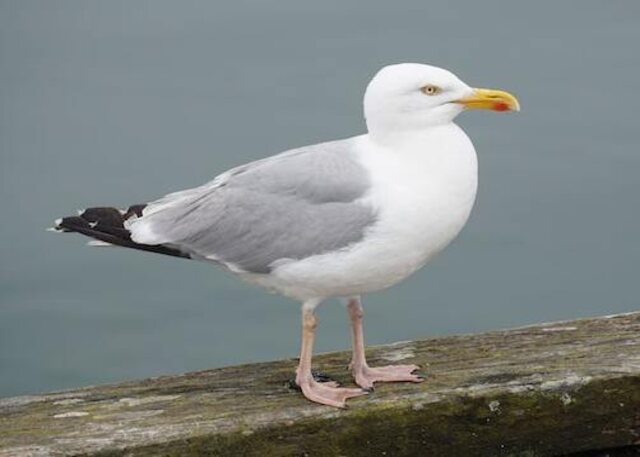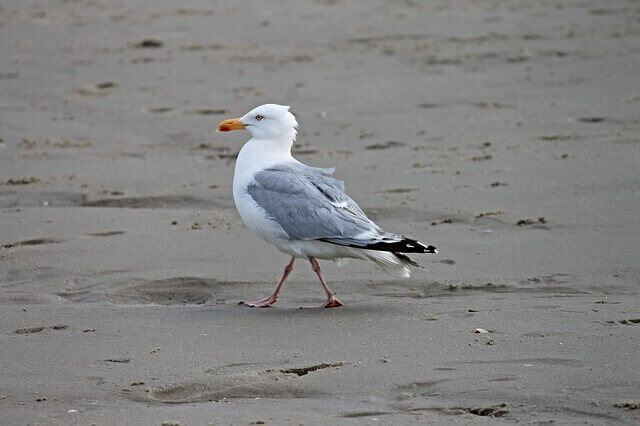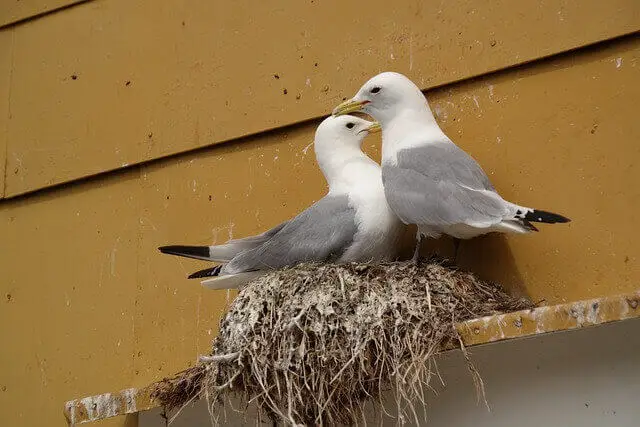Seagulls are a part of our lives. We see them, hear them, and sometimes even interact with them. Yet few people know much about these creatures other than the basics like they live near water or can be annoying at times. In this article, we will explore some amazing or surprising facts about seagulls that you may not have known before.
Click the Play button below to listen to our podcast:
Table of Contents
- 1 Quick Facts About Seagulls
- 2 Seagulls can live for 10–15 Years in the Wild.
- 3 A Seagull can eat up to 20% of its Body Weight in Food each day.
- 4 A Group of Seagulls is called a “Colony”.
- 5 Seagulls Can Fly at Speeds of Up to 30 mph.
- 6 Seagull droppings are called “Guano”.
- 7 Gulls can detect food from over 3 miles away.
- 8 There are over 50 species of seagulls worldwide.
- 9 There are 28 types of gull species seen in North America.
- 10 Seagulls have incredible vision.
- 11 Seagulls have excellent memories.
- 12 Seagulls mate for life.
- 13 Seagulls are found all over the world.
- 14 All seagulls fly in an erratic pattern to protect themselves.
- 15 Seagulls Are Omnivores.
- 16 Seagulls can recognize people by their faces.
- 17 The Most Common Gull in North America is the Herring Gull.
- 18 Most Gull species return to their original nest every year.
- 19 What Do Seagulls Represent in Symbolism?
- 20 The Smallest Seagull Species Is the Little Gull.
- 21 The Largest Seagull Species Is the Great Black-Backed Gull.
- 22 FAQs
- 22.1 Do seagulls mate for life?
- 22.2 How long do seagulls live?
- 22.3 Can seagulls smell food?
- 22.4 Do seagulls remember faces?
- 22.5 Scary facts about seagulls
- 22.6 Can seagulls hear?
- 22.7 How much does a seagull weigh?
- 22.8 Do seagulls have a sense of smell?
- 22.9 How far can a seagull see?
- 22.10 Do seagulls have good eyesight?
- 22.11 How to tell how old a seagull is?
- 22.12 What are seagulls known for?
- 22.13 What does a seagull look like?
- 22.14 How do seagulls detect food?
- 22.15 Why seagulls are amazing birds?
- 22.16 Are seagulls smart?
- 22.17 Do seagulls have good memory?
- 22.18 How fast can a seagull fly?
- 22.19 What is a group of seagulls called?
- 23 Author
Quick Facts About Seagulls
- Scientific Name: Larus spp.
- Order: Charadriiformes
- Family: Laridae
- Suborder: Lari
- Average Length: 22.1-26.0 in (55-67 cm)
- Average Weight: 28.2-44.1 oz (800-1270 g)
- Average Wingspan: 53.9-57.5 in (135-147 cm)
- Range: Worldwide coastal regions
- Habitat: Coastal areas, beaches, cliffs, and inland habitats
- Diet: Opportunistic feeders, consuming fish, small marine creatures, scavenging, and even human food in urban areas.

Seagulls can live for 10–15 Years in the Wild.
While the average lifespan for a seagull in the wild is typically 10–15 years, some individuals have been known to live up to 30 years. This variation in lifespan can be attributed to factors such as diet, habitat, and genetics.
A Seagull can eat up to 20% of its Body Weight in Food each day.
Did you know that seagulls are capable of consuming up to 20% of their body weight in food each day? Considering that the average seagull weighs about 1.5 pounds, this means that a seagull could potentially eat up to 4.8 ounces of food daily. This impressive feeding ability is due to their omnivorous diet, which includes fish, crustaceans, insects, and even garbage.
A Group of Seagulls is called a “Colony”.
Did you know that a group of seagulls is called a “colony”? These colonies can consist of thousands of individual birds and are often found on coastlines, shores, lakes, ponds, and marshes. Seagulls are also known to gather on farms, where they feed on grain crops such as wheat or corn.
These colonies provide seagulls with a sense of safety in numbers and allow them to forage for food more efficiently. However, their large numbers can also lead to conflicts with humans, particularly in urban areas where they are known to scavenge for food.
Seagulls Can Fly at Speeds of Up to 30 mph.
The flight speed of seagulls has been studied by numerous scientists, who have found that these birds are capable of achieving impressive speeds. In headwind conditions, seagulls can maintain an average flight speed of about 23-25 mph, while in tailwind conditions, they can reach speeds of 29-30 mph.
This remarkable ability to navigate through different wind conditions is due to their aerodynamic body shape and powerful wings. Seagulls use their speed and agility to hunt for prey, evade predators, and travel long distances during migration.
Seagull droppings are called “Guano”.
Seagull droppings, also known as guano, have been used as fertilizer for plants and crops for centuries. Guano is a natural fertilizer made up of the excrement of seabirds, bats, and seals that inhabit coastal areas and islands. It consists primarily of nitrogen-rich ammonia salts, which provide essential nutrients to the soil.
Guano is known for its high concentration of phosphorus and potassium, making it a valuable resource for farmers and gardeners. However, the harvesting of guano can have negative impacts on seabird populations, and sustainable harvesting practices must be implemented to ensure their conservation.
Gulls can detect food from over 3 miles away.
Seagulls have an incredible sense of smell that enables them to detect even the faintest trace of food from over 3 miles away. This ability to locate food is a crucial factor in the survival of many seagull species. Seagulls use sensitive nerve endings called Jacobson’s organs, located inside their nostrils, to detect odors in the air.
These organs are highly specialized and allow seagulls to distinguish between different scents, helping them to locate food sources more efficiently. This remarkable ability to detect food from afar has also made seagulls a common sight in urban areas, where they scavenge for food in garbage cans and dumpsters.
There are over 50 species of seagulls worldwide.
Seagulls are a diverse group of birds, with over 50 species found worldwide. Among these species, four types are particularly common: the common gull, the herring gull, the little gull, and the yellow-legged gull. These four species are known for their distinctive appearance, with varying sizes, colors, and markings.
While they share many characteristics, such as their omnivorous diet and coastal habitat, each species has its own unique adaptations and behaviors. Understanding the differences between these species can provide valuable insights into the ecology and evolution of seagulls as a whole.
There are 28 types of gull species seen in North America.
Seagulls are a widespread group of birds found all over the world. In North America alone, there are 28 different species of seagulls, each with its own unique characteristics. These species vary in size, color, and shape, with some being larger and more robust than others.
Seagulls also have diverse nesting habits, with some building nests on the ground or cliffsides, while others construct floating nests on the water’s surface. Understanding the different species and their behaviors can provide valuable insights into the ecology and evolution of these fascinating birds.
Seagulls have incredible vision.
Seagulls have remarkable vision, with the ability to see clearly from distances of up to 2 miles away. Their eyes are positioned on the sides of their head, giving them a panoramic view of their surroundings.
This unique feature allows seagulls to detect predators approaching from all directions and take flight before it’s too late. Seagulls also have excellent depth perception, which is essential for diving and catching prey in the water.
Their keen visual acuity is a crucial adaptation that has allowed seagulls to thrive in diverse habitats, from coastal areas to inland lakes and rivers.
Seagulls have excellent memories.
Seagulls have impressive memories, with the ability to remember specific people’s faces and the locations of hidden food from days ago. They are also able to recognize other seagulls who they associate with as friends or enemies, based on their calls.
This remarkable ability to remember and recognize individuals is due to their highly developed brains and advanced cognitive abilities. Seagulls use this information to navigate their environment, locate food sources, and avoid potential threats.
Their social intelligence and memory skills have also made them a popular subject of study in the field of animal behavior and cognition.
Seagulls mate for life.
Seagulls are monogamous birds that form strong lifelong bonds with their partners. Once paired, they work together as a team to find food, protect the nest, and raise their chicks. The male seagull typically takes on the role of the primary food provider, while the female is responsible for incubating the eggs and caring for the young chicks.
This division of labor allows seagulls to efficiently raise their young and ensure the survival of their offspring. Seagulls are known for their strong family bonds, and they often return to the same nesting sites year after year to raise their young.
Their monogamous behavior and family dynamics have made them a popular subject of study in the field of avian behavior and ecology.
Seagulls are found all over the world.
Seagulls are a ubiquitous bird found all over the world, inhabiting every continent, including Antarctica. They are often associated with coastal regions, seaside towns, fishing villages, and inland waterways, but can also be found in some inland locations.
Seagulls are one of the most commonly seen birds in cities, where they scavenge for food in garbage cans, docks, and parks. These adaptable birds have learned to thrive in urban environments, taking advantage of the abundant food sources found in human settlements.
While they are often viewed as a nuisance by some, seagulls play an important role in the ecosystem, helping to control populations of small animals and insects.
All seagulls fly in an erratic pattern to protect themselves.
Seagulls have developed a unique flying behavior called “jinking” to protect themselves from predators. This behavior involves flying in an erratic pattern, with unpredictable and constantly changing movements, making it difficult for predators such as falcons or hawks to predict their next move.
Jinking allows seagulls to confuse and evade predators, increasing their chances of survival. This behavior is a crucial adaptation that has allowed seagulls to thrive in diverse habitats, from coastal areas to inland lakes and rivers.
The study of jinking behavior in seagulls has also provided valuable insights into the ecology and evolution of avian predator-prey interactions.
Seagulls Are Omnivores.
Seagulls have an omnivorous diet that includes a variety of foods. While they primarily feed on seafood such as crabs, clams, mussels, shrimp, and small fish, they are also known to scavenge for scraps of human food left behind by tourists or in trash cans when humans aren’t looking.
Seagulls also eat various types of insects and worms, as well as sea vegetation like seaweed and kelp. Their adaptable diet allows seagulls to thrive in diverse environments, from coastal areas to urban centers.
However, their scavenging behavior has also led to conflicts with humans, particularly in areas where they are considered a nuisance. Understanding the dietary habits of seagulls is crucial for managing their interactions with humans and preserving their role in the ecosystem.
Seagulls can recognize people by their faces.
Seagulls have been found to have impressive facial recognition abilities and are able to recognize individual people by their faces. Researchers have discovered that seagulls can identify and remember people, particularly those who interact with them or provide them with food.
This suggests that seagulls have advanced cognitive abilities, including the ability to distinguish between different human emotions based on body language and voices.
This remarkable skill is just one example of the complex social and cognitive behaviors exhibited by seagulls and has led to further research into the intelligence and emotional lives of these fascinating birds.

The Most Common Gull in North America is the Herring Gull.
The Herring Gull is one of the most common seagulls found in North America, with a range that extends throughout all the lower 48 states and Canada. While their numbers may decrease in the northern parts of Alaska, they are still prevalent in many other regions.
This species is known for its adaptability, being one of the few seagulls that can thrive both inland and on coastlines. Herring Gulls are opportunistic feeders, with a diet that includes fish, insects, and even small mammals.
Their versatility and resilience have made them a popular subject of study in the field of avian ecology and behavior.
Most Gull species return to their original nest every year.
Many species of seagulls have an impressive ability to return to their original nesting site year after year. Some gulls can even find their way back to their nest within a span of two years, which is a remarkable feat.
This ability is due to their advanced spatial memory, which allows them to remember the location of their nest and find it with ease. Seagulls also tend to use the same nesting site for generations, making them more vulnerable to human disturbance and other environmental problems.
Their strong attachment to their nesting site underscores the importance of preserving and protecting seagull habitats. Understanding the remarkable memory skills of seagulls can provide valuable insights into the ecology and behavior of these fascinating birds.
What Do Seagulls Represent in Symbolism?
The seagull has been a symbol of healing, wisdom, and tranquility throughout history. The belief that seagulls are messengers from the creator can be traced back to Ancient Greece, where they were associated with the god Apollo.
In Native American symbolism, seagulls represent peace and prosperity, as well as emotional balance and strength in numbers. Seagulls are also seen as a symbol of freedom, with their ability to soar through the skies and navigate the open sea.
Their graceful flight and serene demeanor have made them a popular subject of art and literature, inspiring countless works that celebrate their beauty and symbolism.
The enduring cultural significance of seagulls underscores their importance as a beloved and respected species in many cultures around the world.
The Smallest Seagull Species Is the Little Gull.
The Little Gull is the smallest species of seagull, measuring between 11.5-12 inches (29.2-30.5 cm) in length and weighing between 3.5-5.29 ounces (100-150 g). It has a wingspan of approximately 24.4 inches (62 cm).
Despite its small size, the Little Gull is a highly adaptable bird found in a variety of habitats, including freshwater lakes, rivers, and wetlands. It feeds on insects, small fish, and crustaceans, and is known for its agile and acrobatic flight patterns.
The Little Gull’s small size and unique characteristics make it a popular subject of study in the field of avian ecology and behavior.
The Largest Seagull Species Is the Great Black-Backed Gull.
The Great Black-backed Gull is the largest species of seagull, found throughout Europe, Asia, and North America. Measuring between 25-31 inches (65-80 cm) in length, with a weight of 0.75-2.3 kg (1.7-5.1 lb) and a wingspan of 1.5-1.7 meters (4 ft 11 in-5 ft 7 in), this impressive bird is known for its size and strength.
Great Black-backed Gulls are opportunistic feeders, preying on fish, small mammals, and even other birds. They are also known for their aggressive behavior, often displacing other birds from their feeding areas.
Despite their intimidating size, Great Black-backed Gulls are an important part of the coastal ecosystem, helping to control populations of small animals and insects.
The study of Great Black-backed Gulls has provided valuable insights into the ecology and behavior of seagulls as a whole.
FAQs
Do seagulls mate for life?
Seagulls typically do not mate for life. They often form monogamous pairs for a breeding season, but these pairings can change from year to year. Some species may show more fidelity in their pair bonds than others, but long-term monogamy is not the norm.
How long do seagulls live?
Seagulls have varying lifespans by species and environmental factors. On average, they can live for 10-15 years, with larger species having longer lifespans. Predation, food availability, and environmental conditions play crucial roles in determining their longevity.
Can seagulls smell food?
Yes, seagulls have a well-developed sense of smell. They use this olfactory ability to detect food from a distance, especially fish and other prey. It aids in their foraging behavior, helping them locate food sources on land or at sea.
Do seagulls remember faces?
There is evidence that some seagull species, like the Herring Gull, can recognize and remember individual human faces, particularly if they’ve had previous interactions with them. This recognition may be linked to their ability to associate certain faces with food sources.
Scary facts about seagulls
While not necessarily “scary,” seagulls can become urban pests due to their adaptability to human environments. They are known for scavenging for food in populated areas, sometimes leading to human-wildlife conflicts.
Can seagulls hear?
Yes, seagulls have excellent hearing. They rely on auditory cues for communication, locating potential food sources, and detecting threats or predators, particularly in their social interactions and foraging behavior.
How much does a seagull weigh?
Seagulls vary in weight by species. Smaller species may weigh around 200 grams, while larger species can reach up to 1.5 kilograms. Weight also depends on age, sex, and environmental conditions.
Do seagulls have a sense of smell?
Seagulls possess a keen sense of smell, which is particularly useful in locating food. They can detect scents in the air, aiding in their ability to find prey, carrion, or discarded food.
How far can a seagull see?
Seagulls have exceptional vision, allowing them to see over considerable distances. They can spot potential food sources, including fish on the water’s surface, from several hundred meters away. This keen eyesight aids in their hunting and foraging activities, making them highly efficient predators.
Do seagulls have good eyesight?
Seagulls have exceptional eyesight, critical for their survival. They rely on sharp vision for hunting, navigation, and identifying potential threats, predators, or competitors in their environment.
How to tell how old a seagull is?
Determining a seagull’s age can be challenging without specific markings. Juvenile seagulls typically have mottled plumage, while adults have more uniform plumage. Aging can also be estimated by observing their behavior and physical features.
What are seagulls known for?
Seagulls are renowned for their adaptability to various environments, distinct calls, scavenging behavior, and their association with coastlines and urban areas. They are often seen near bodies of water searching for food.
What does a seagull look like?
Seagull appearances vary by species, but they typically have a sleek body, long wings, webbed feet, and a distinctive hooked bill. Plumage colors differ, ranging from white to various shades of gray and brown.
How do seagulls detect food?
Seagulls rely on their keen vision and sense of smell to locate food sources. Their sharp eyesight helps them spot potential prey, while their olfactory senses aid in detecting scents from afar, guiding them to potential food.
Why seagulls are amazing birds?
Seagulls are remarkable for their ability to adapt to diverse ecosystems, their aerial agility, and their resourceful foraging strategies. They play significant roles in ecosystems and are fascinating subjects for research.
Are seagulls smart?
Seagulls exhibit a degree of intelligence, displaying problem-solving skills, social learning, and adaptability in acquiring food and adapting to changing environments. Their behaviors suggest a level of cognitive flexibility.
Do seagulls have good memory?
Research suggests that seagulls, especially certain species, have reasonable memory capacity. This memory aids in locating food sources, recognizing potential threats, and navigating their environment effectively.
How fast can a seagull fly?
Seagull speeds vary by species, but they can generally reach speeds of 20 to 40 miles per hour (32 to 64 kilometers per hour) in level flight. Their ability to maneuver and glide efficiently is remarkable.
What is a group of seagulls called?
A group of seagulls is commonly referred to as a “colony,” “flock,” or “gull colony.” These social birds often gather in large numbers, particularly near food sources or suitable habitats.




